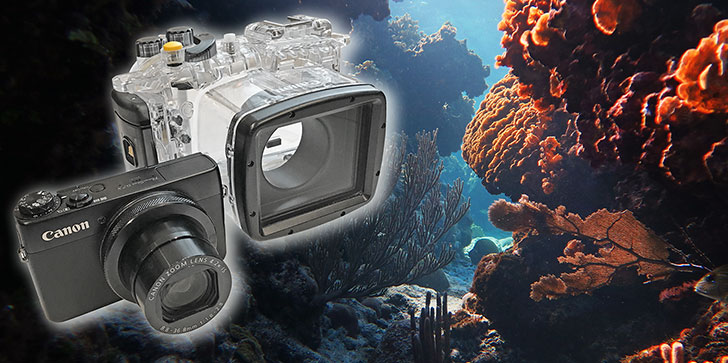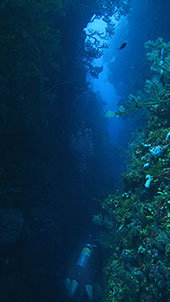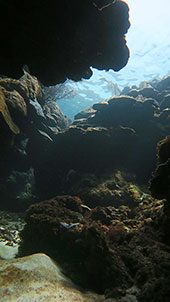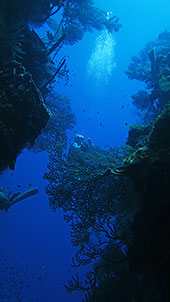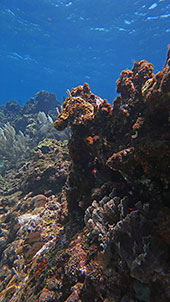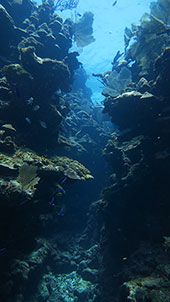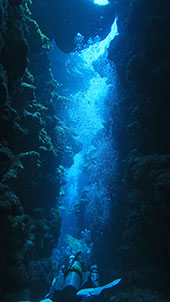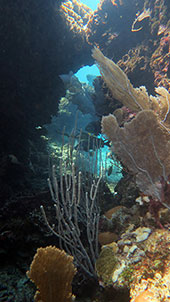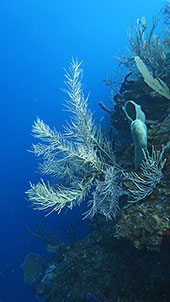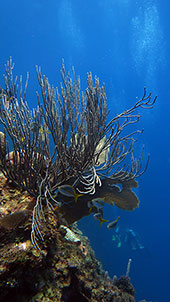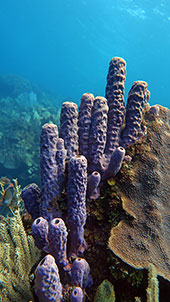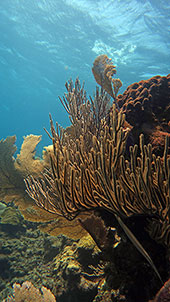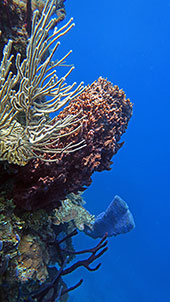|
The Canon G7x / WP-DC54 housing
Why this remarkable compact has become our go-to camera on dive trips, and why it works so well underwater
by Conrad H. Blickenstorfer
Time to talk about cameras, underwater cameras. We've tested and reviewed a large number of cameras underwater over the years, both with and without housing. Initially, it was safe to say that the average underwater photographer would get one decent shot out of ten, if that. That's a rough estimate, of course. The number of good shots depends on water condition, light, skill level of the photographer, and the camera itself. But, overall, the one good shot in ten pretty much applied across the board.
That has changed dramatically. With even moderate skills and observing just a few rules, today's cameras yield a far higher percentage of good shots. In fact, on a recent underwater product testing trip to the Honduran island of Roatan we found that most pictures were good. By "good" I mean sharp, good color, the works. Like the one below.
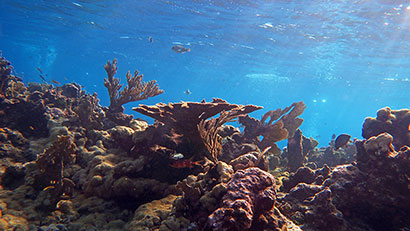
We shot this, and hundreds of other underwater pictures, with a Canon Powershot G7x inside a Canon WP-DC54 underwater housing. The G7x has since been replaced with the G7x Mk II, so whatever results we got with the G7x would be as good as we got, and most likely even better.
I've been using Canon Powershot G series cameras for many years, going back to the earliest models. Each new version added capabilities and left lasting memories, almost all good. At times there was a glitch or two, which Canon almost always fixed in the next version (examples were excessive barrel distortion with the G10, and new technology issues with the G15 that switched from CCD to CMOS imagers). But overall, the Powershot G-Series was and is spectacular.
Time moves on, of course, and eventually the G-Series models began feeling a bit big and heavy. Canon fixed that with the Gxx series of smaller, lighter cameras that gave up nothing in terms of features, but were a lot handier.
I was initially attracted to the G7x due to size and specs. As it turned out, there was much more to the camera than that. Though we have all sorts of photography gear in our office at any time, the G7x quickly became my "go-to" camera, the one I instinctively pick up for most kinds of shooting.
What I didn't expect is the camera's underwater performance. Canon has always been good about making reasonably priced underwater housings for its cameras, and the G7x is no exception.
On our product testing trip, the G7x performed so well underwater that I ended up using it on most dives, even though we had brought along several others, among them the usual assortment of GoPros.
What set the G7x apart? Was it a particularly rich set of features and settings? Some unusually advanced tech specs? Another revelation? It certainly had much of this but, nope, the G7x won me over by doing the basics better than any camera I have used underwater.
How underwater photography is different
Here I need to touch upon a few things about underwater photography. It is completely different from shooting on dry land. Totally different. For one thing, you need live-support equipment to even be underwater. You wear a mask, protective underwater gear, often gloves, and you have to deal with dive computers, pressure gauges, and keeping an eye on your depth and the length of time you can be underwater, which varies with exertion, depth, and conditions. In addition, you are never totally still, and everything around you is in constant motion.
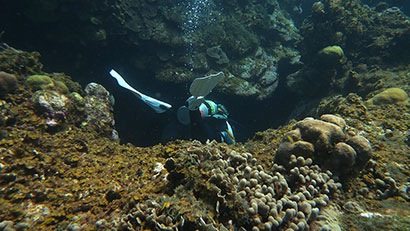
Then there are the physics of shooting underwater. Light acts differently. Refraction is different. Colors gradually fade away as you go deeper, starting with red, then orange, then yellow, until everything is a uniform tint of greenish-blue. Light gets less and less with increasing depth. And unlike air that does not have visible particles in it, underwater there is almost always a haze of all sorts of flotsam. That makes use of lights and flash a science, since all those particles reflect and show up as "back scatter," as if you were shooting through falling snow.
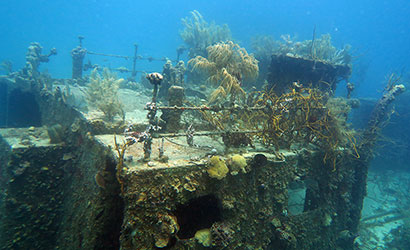
What all of this means is that shooting underwater is much more difficult than taking pictures on dry land. Conditions are fundamentally different. A camera that was solely developed to shoot on dry land will inevitably struggle underwater.
Why? Because the combination of all that is different underwater means photography itself is different. A big array of features and settings is a negative rather than a positive. Controls that work perfectly well above water are difficult to use beneath the surface. Tiny markings and labels, easily readable on dry land, become illegible. A viewfinder or LCD screen that is perfectly adequate on land becomes useless underwater.
Why the Canon G7x excels underwater
The name of the game for underwater shooting is keeping things as simple and obvious as possible. Because underwater you do not have the time to fiddle with settings. In order to be good for underwater shooting, a camera must take care of all the basics so that the photographer can concentrate on the subject and handling the complex task of being underwater.
The G7x did that fabulously. Eight of every ten pictures I took came out great. Which is phenomenal. And it may be different for other photographers and under different conditions. But for me, the G7x was perhaps the first camera in which I had complete trust to shoot mostly great pictures when underwater.
What did I do to make that happen? Very little. I switched to Underwater Mode. I selected either Macro or Normal. I selected either Flash or No Flash. Nothing else. That yielded eight out of ten great pictures no matter what and where I shot. That is remarkable.
What kind of wizardry did Canon bake into the G7x to make that possible? I don't know. But the Canon folks obviously have people who are divers and understand what matters beneath the surface. That cannot be said of all camera companies. White balance, for example, is exceptionally important, even more than on dry land. Because colors vary with depth and the camera must compensate in highly complex ways. Lesser cameras either can't do that at all, do it poorly, or put the burden on the user via filters manual depth settings, or multiple underwater modes. The G7x, on the other hand, simply has that one competent underwater mode and an automatic white balance that is capable of handling the underwater world. In the past I had to bring along a white tablet or seek some white surface to manually set the white balance underwater. Not with the G7x. You can adjust white balance underwater, but it's hardly ever necessary.
Between that and a few simple rules eight out of ten pictures came out great, dive after dive. What are those simple rules?
- A) Know when to use flash and when not.
- B) Flash is mostly for macro in deeper water.
- C) In normal shooting, flash must be off.
Even the tiniest bit of flotsam will result in scatter with a pop-up flash, even if the light is diffused with a snap-on semi-opaque shield as the Canon underwater housing for the G7x has. Know when to use macro and when normal. And know when conditions are such that good photography simply is not possible. Which means, of course, that experience does matter to a degree. Even so, the G7x is your friend underwater, not a frustration.
On our wishlist
Is the camera perfect? Nothing ever is. Especially not with add-ones like external lights or whatever. The LCD, relatively large though it is, seems small and hard to read in a world accustomed to big-screen super-sharp and super-bright smartphones.
Battery life is an issue. I usually made it through two one hour dives, but only if I turned the camera off whenever I did not shoot. The G7x is large enough for Canon to have given it a larger battery than the puny one it has. A diver knows that underwater, or even on a dive boat, you can't just pop in a new battery.
While it's reasonably easy to get pictures and video off the G7x, in a world spoiled by Apple AirDrop and the Android equivalents, prying out the card and upload to a tablet or laptop for viewing is a drag.
And, sadly, menus on dedicated cameras have not kept up with the times. It's still confusing, low-res, upper case and all. And for the times when you forget to put in a memory card, which does and will happen, there is no internal memory. In a world where 16GB is the minimum for a phone, a few gig of storage should be in a decent camera.
Why the G7x and not a smartphone
And speaking of smartphones that are replacing dedicated cameras almost everywhere, why did I not simply put my iPhone in a case for shooting underwater? Mainly because my life is on that phone. Losing it or flooding it is not an option. But it's more than that. Cameras in today's phones have become amazingly good, but, for now, they can't touch the big 1-inch imager, big optical zoom, and inherent imaging intelligence of a dedicated "real" camera.
Canon G7x: bottom line
When it comes to shooting underwater pictures and videos, divers have many options. While smartphones rule on dry land when it comes to taking pictures, you don't see many smartphones in underwater cases. GoPros have taken over, but as much as we like them, their strong side is taking action video, not so much still pictures. 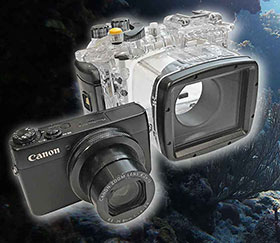 There are still serious underwater photographers who, on a quest for perfection, spend many thousands on massive setups. There is no one answer. There are still serious underwater photographers who, on a quest for perfection, spend many thousands on massive setups. There is no one answer.
Canon's G7x offers a perfect middle ground. It's a camera that's small and handy enough even in its underwater housing to never get much in the way. It's competent enough to, with just a little practice, shoot consistently great pictures. Its automatic settings always seem to know just what to do. Underwater, that's not easy, and few cameras get it right. And that is why, again and again, the Canon G7x is our go-to camera underwater. -- Conrad Blickenstorfer, March 2019
|








